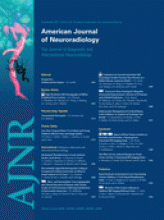We thank Dr Linn for her response to our letter entitled “Extracranial Internal Carotid Artery Stenosis as a Cause of Cortical Subarachnoid Hemorrhage.”1 We certainly agree that cerebral amyloid angiopathy (CAA) is an important cause of focal sulcal subarachnoid hemorrhage (fsSAH) in the elderly. We further appreciate that patients with histologic evidence of CAA may manifest radiologically as having superficial siderosis (SS) without evidence of macro- or microbleeds.2 However, we disagree that CAA is the leading differential consideration in our particular case.
A recent study of the Boston criteria by Linn et al2 demonstrated that the addition of SS as a diagnostic criterion improves the sensitivity for identifying CAA-related hemorrhage to 94.7%. Therefore, in our case in which there was no MR imaging evidence of CAA (including no evidence of SS), the likelihood of CAA should be low if the study is correct. Unfortunately, the definitive diagnosis requires a histopathologic specimen, which was thought to be unnecessary and aggressive in a patient who did not meet criteria for “possible CAA” by using the Boston criteria.3
Moreover, the Boston criteria and the modified version proposed by Linn et al2 require that other causes of intracranial hemorrhage be excluded.3 As we have described in our letter, steno-occlusive disease is a recognized cause of fsSAH, which is supported by numerous reports in the literature.4–6 In fact, a recent article by Raposo et al,7 which examines the association of CAA and cortical SAH, excludes those patients with apparent causes of SAH including carotid occlusion.
We commend Dr Linn for her work on the “modified” Boston criteria2 to increase the sensitivity for the diagnosis of CAA and look forward to its further validation. However in our specific case, we maintain that our postulated hemodynamic cause is the likely mechanism for fsSAH.
References
- © 2011 by American Journal of Neuroradiology












